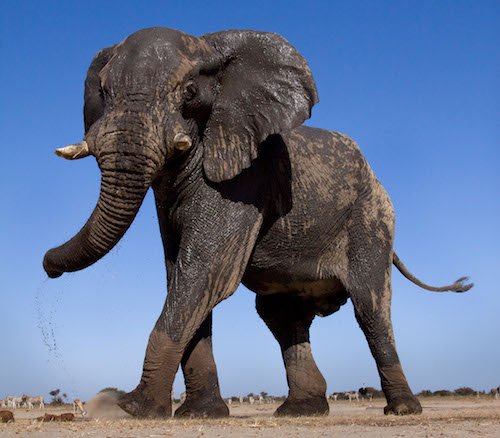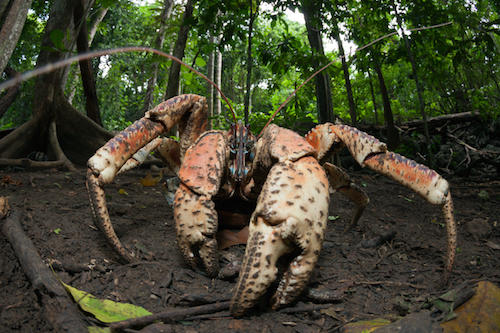Communiqué
Nature’s Biggest Beasts | NATURE | Premieres Wednesday, November 13 at 8
< < Back toNature: Nature’s Biggest Beasts
Premieres Wednesday, November 13 at 8 p.m. on PBS, pbs.org/nature and the PBS Video app
Being massive can have its advantages, but it brings equally immense challenges to survive. Big bodies need more fuel, more space and can attract unwanted attention. Take the world’s largest lizard, the Komodo dragon, whose huge appetite means it must take on prey ten times its weight; or the tallest of them all, the giraffe, who with such a long neck must control immense blood pressure. From the 150-ton blue whale who can suck up four tons of krill a day, to Japan’s finger-length giant hornets that can decimate a hive of 30,000 bees to feed on their larvae, nature’s biggest beasts must go to extraordinary lengths to thrive. These are their epic survival stories.

- Blue whale
- Giraffe
- Komodo dragon
- Armored ground cricket
- Kinabalu giant red leech
- Bornean blue earthworm
- Powelliphanta snail
- Giant hornet
- Little red flying fox
- Polar bear
- Mountain stone weta
- African elephant
- Great white shark
- Orca
- Giant Pacific octopus
- Humboldt squid
- Ostrich
- Albatross
- Hippopotamus
- Robber (Coconut) crab
- Coral Reef
Noteworthy Facts:
- In dry times, giraffes eat at dawn when condensation is high, so they can absorb most of the moisture from leaves.
- The Humboldt squid works in packs, eating through nine tons of fish a night. However, if food is scarce, these squids are known to eat each other.
- Although the Bornean blue earthworm spans approximately 27.5 inches, it serves as prey to the much smaller Kinabalu giant red leech, which spans about 19.5 inches.
- To keep cool, hippos give birth in the water. The 100-pound baby hippo can’t breathe underwater, so the new mom has about 40 seconds to get the baby hippo onto dry land for its first gulp of air.
- A female Robber crab risks her life once a year to pass on her genes. Once she has mated and nursed her fertilized eggs, she must release them into the water to hatch. But the Robber crab can’t swim and is so adapted to land that she has evolved a form of lung that can’t breathe underwater. If she falls into the sea, she’ll drown.

Buzzworthy Moments:
- Giant hornets feed on the larvae of honeybees, and a team of 30 giant hornets can eat through a beehive of 30,000 in just a few hours. However, to get to this meal it must fight its way into the hive. When a hornet shows up to a beehive ready to feast, to his surprise the bees welcome him in. While the hornet chows down on an unlucky bee, a swarm of bees attack him. By vibrating their flight muscles, bees can generate enough heat to cause the hornet to overheat and die.
- The Komodo dragon is the world’s largest lizard, and it has an appetite that’s even bigger. In one sequence, a Komodo dragon sets it sight on dinner – a buffalo ten times its size. Inside of the Komodo dragon’s jaw is a venom gland, a bite that releases poison into the prey, preventing blood from clotting. The Komodo dragon bites at the buffalo a few times and plays the waiting game. The buffalo’s wound doesn’t heal, and it begins to have a hard time moving. Seeing this, the Komodo dragon attacks the defenseless buffalo.
- To sustain their huge frames, the Armored ground cricket must pack on the protein. Their food of choice is Red-billed quelea chicks, and to reach their nest, the crickets have to get past the parent. The Armored ground cricket quickly makes his way up the tree, only to be spotted by the quelea. The quelea pecks at the cricket, who counters by firing blood from the pores in its exoskeleton that temporarily blinds the quelea. The cricket then makes its way up to the nest to feast on the quelea chicks.
- When the perfect tide, day length, and sea temperature align, 400 species of coral reproduce over a series of nights. Tucked inside their limestone armor, millions of coral polyps release their eggs and sperm simultaneously. Together they are responsible for the world’s largest growing, single-living structure – the Great Barrier Reef.
Series Overview:
Nature is a voice for the natural world, bringing the wonders of wildlife and stories of conservation to millions of American viewers. The series has won more than 700 honors from the television industry, the international wildlife film communities and environmental organizations, including 18 Emmys and three Peabody Awards.

